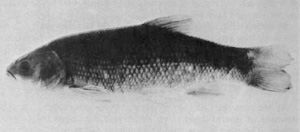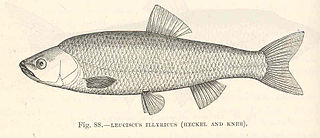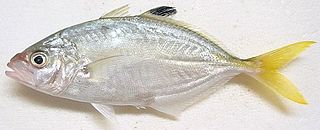
Tilapia is the common name for nearly a hundred species of cichlid fish from the coelotilapine, coptodonine, heterotilapine, oreochromine, pelmatolapiine, and tilapiine tribes, with the economically most important species placed in the Coptodonini and Oreochromini. Tilapia are mainly freshwater fish inhabiting shallow streams, ponds, rivers, and lakes, and less commonly found living in brackish water. Historically, they have been of major importance in artisanal fishing in Africa, and they are of increasing importance in aquaculture and aquaponics. Tilapia can become a problematic invasive species in new warm-water habitats such as Australia, whether deliberately or accidentally introduced, but generally not in temperate climates due to their inability to survive in cold water.

Scleropages jardinii, the Gulf saratoga, Australian bonytongue, pearl arowana or northern saratoga, is a freshwater bony fish native to Australia and New Guinea, one of two species of fishes sometimes known as Australian arowana, the other being Scleropages leichardti. It has numerous other common names, including northern saratoga, toga and barramundi. It is a member of the subfamily Osteoglossinae, a (basal) teleost group. Its scientific name is sometimes spelled S. jardini.

The silver trout is an extinct char species or subspecies that inhabited a few waters in New Hampshire in the United States prior to 1939, when a biological survey conducted on the Connecticut watershed by the New Hampshire Fish and Game Department found none.

The thicktail chub was a type of minnow that inhabited the lowlands and weedy backwaters of the Sacramento and San Joaquin Rivers in the Central Valley of California. It was once abundant in lowland lakes, marshes, ponds, slow-moving stretches of river, and, during years of heavy run-off, the surface waters of San Francisco Bay. The thicktail chub was one of the most common fish in California. Within Native American middens it represented 40% of the fish.

The asp is a European freshwater fish of the Cyprinidae family. It is sometimes considered by taxonomic authorities to be one of two members of the genus Aspius. It is protected under Appendix III of the Bern Convention and listed as least concern on the IUCN Red List.

The scoophead is a little-known species of hammerhead shark, part of the family Sphyrnidae. It inhabits the tropical waters of the western Atlantic Ocean, from Panama to southern Brazil, and in the eastern Pacific Ocean from the Gulf of California to Ecuador, and probably northern Peru, as well. It is found in shallow, inshore habitats.

The Australian marbled catshark is a coloured catshark of the family Atelomycteridae, found in the eastern Indian Ocean, endemic to Western Australia between latitudes 12 and 21°S, from the surface to 245 m (800 ft) deep. Its length is up to 60.0 cm, and it typically inhabits coastal waters with sandy or rocky bottoms.

The whitefin topeshark is a houndshark of the family Triakidae, found only in the tropical waters of the Philippines between latitudes 20° N and 5° N. They inhabit the coastal areas. They can grow up to a length of 96 cm. Adolescent specimens have dark areas on their caudal fins. The reproduction of this shark is ovoviviparous.

The spotted tilapia, also known as the spotted mangrove cichlid or black mangrove cichlid, is a species of fish of the cichlid family. It is native to fresh and brackish water in West and Central Africa, but has been introduced to other regions where it is considered invasive.
Labeobarbus mariae is a species of cyprinid fish.

Squalius illyricus, the Illyrian chub, is a species of ray-finned fish in the family Cyprinidae. It inhabits karstic waters of Bosnia and Herzegovina, Croatia and Albania. Its natural habitats are rivers and water storage areas. It is threatened by habitat loss.

The Ukrainian brook lamprey is a species of lamprey in the Petromyzontidae family. It is found in brackish and freshwater areas in Austria, Belarus, Bulgaria, the Czech Republic, Georgia, Hungary, Moldova, North Macedonia, Poland, Romania, Russia, Serbia, Montenegro, Slovakia, Turkey, and Ukraine. It invaded the basin of the Volga River in 2001.
The pinewoods darter is a species of freshwater ray-finned fish, a darter from the subfamily Etheostomatinae, part of the family Percidae, which also contains the perches, ruffes and pikeperches. It is endemic to the eastern United States where it is only known to occur in the Little Peedee River system in the Carolinas. It inhabits creeks, preferring gravel riffles and vegetated areas with strong currents. This species can reach a length of 7.6 centimetres (3.0 in) TL though most only reach about 5.2 centimetres (2.0 in).

Galaxiella munda is a species of fish in the family Galaxiidae. It is endemic to inland waters of southwestern Australia, and known as the Western mud minnow. In 1999 the Mud Minnow was not included in the list of threatened species under the Environment Protection and Biodiversity Conservation Act, but is listed as Endangered on the IUCN Red List.

Knipowitschia punctatissima, the Italian spring goby, is a species of goby endemic to Italy where it inhabits fresh, clear waters of springs, streams, and channels with slow water movements. This species can reach a length of 4.5 centimetres (1.8 in) SL.

The Tanganyika lates is a species of lates perch endemic to Lake Tanganyika. It is a widespread predator on other fishes. This species can reach a length of 200 centimetres (79 in) SL and the greatest recorded weight is 100 kilograms (220 lb). This species is important commercially and is also popular as a game fish. It is threatened by the pressures that these activities put upon the population.

The brownback trevally, also known as the brown-backed trevally, is a species of small inshore marine fish classified in the jack family, Carangidae. The brownback trevally is distributed in two populations through the tropical waters of the Indo-west Pacific region, ranging from the Persian Gulf east to India, South East Asia and the Indonesian islands. The species is distinguished from similar species by its completely scaled breast and black-tipped second dorsal fin, and is known to reach a maximum length of 25 cm. The brownback trevally inhabits inshore waters including bays and estuaries, where it preys on demersal crustaceans and small fish. Other aspects of its biology are poorly known, and it is of minor importance to fisheries, occasionally caught by hook and line or trawls. William Smith-Vaniz has recently suggested the two distinct populations may actually represent two distinct species.

The round sardinella is a species of ray-finned fish in the genus Sardinella found in both sides of the Atlantic Ocean and the Mediterranean Sea.

The leerfish or garrick is a species of marine fish in the family Carangidae, and is native to the Mediterranean and the coastal waters of western Africa to the coastal waters of eastern South Africa. Also recorded in the Black Sea. These fish can reach 1.5 m in length and more than 30 kg in weight. They inhabit the coastal wave zone where they form small shoals to hunt other smaller fish, favouring mullets.
Enneapterygius flavoccipitis, the yellownape triplefin or northern bicoloured triplefin, in Australia, is a species of threefin blenny in the genus Enneapterygius.

















